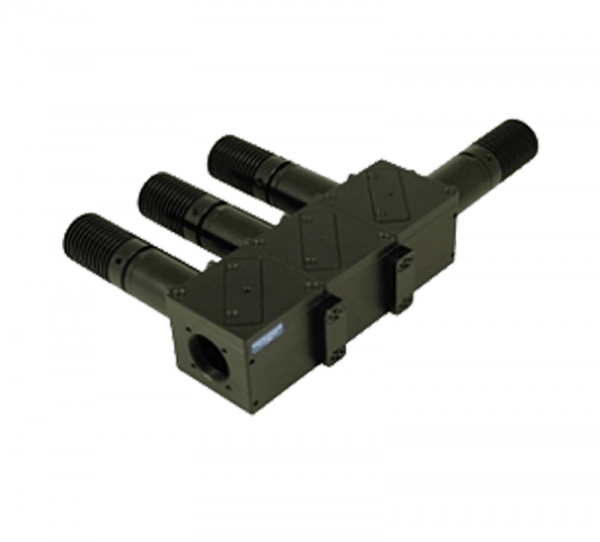
Multiple Wavelengths with Beam Combiners; UV-NIR; 365-980 nm; 0.84-15 W per LED Light Source; Iop 350-3,500 mA per LED Light Source; Vop 1.4-15.5 V; Typ. Output Power 30-1,500 mW per LED Light Source
With Mightex’s multi-wavelength collimated LED light sources, multiple LED sources can be efficiently combined into a single output beam and offer major advantages such as long lifetime, easily tuneable spectrum, high power stability, and ultra-fast switching (µs level) without using moving mechanical components.
The light source’s single collimated output beam is often further coupled into an optical systems. The highly collimated multi-wavelength output beam is suitable for working with lenses , filters , dichroic, mirrors , and many other optical components , while simultaneously allowing the user to tailor the spectrum to best suit the specific application requirements.
Mightex’s multi-wavelength collimated LED light sources can be constructed by combining the following components:
- Mightex LCS-BC25 multi-wavelength beam combiners; and
- Mightex high-power LCS-Series collimated LED light sources.
For details on these two product series, please refer to the downloadable datasheets.
Depending on the specific configuration geometry, multi-wavelength collimated LED light sources can be largely categorized into two groups:
- “Straight-through” type, in which each additional LED/wavelength is added to the assembly in series, and hence the first LED/wavelength will have the longest optical path length while the last LED/wavelength will have the shortest; or
- “Equal-path” type, in which all LEDs/wavelengths have equal optical path length at the output.
Below is a step-by-step guide on how to construct a multi-wavelength collimated LED source:
Step 1: Select your desired collimated LED sources (up to 8 or more LEDs) based on wavelengths and output powers, according to the specific requirements for your application.
Currently, only 22 mm diameter collimated LEDs can be DIRECTLY combined using Mightex LCS-BC25 multi-wavelength beam combiners, while 11 mm diameter collimated LEDs can be attached to a beam combiner using an adapter and then combined.
Low-power collimated LEDs (e.g. 5 W or below) have a Type-A package, while high-power collimated LED’s (e.g. 7 W or above) have a Type-B package (with a cooling fan).
Step 2: Rank the selected collimated LEDs by their wavelengths (from long to short). For example, a customer may choose the following four LEDs for his specific application:
- LED#1, 740 nm, 1 W, Type-A;
- LED#2, 590 nm, 10 W, Type-B;
- LED#3, 530 nm, 15 W, Type-B; and
- LED#4, 470 nm, 5 W, Type-A.
(I) “Straight-through” Type
Step 3: Combine LED#1 and LED#2 (i.e. the two LEDs with the longest wavelengths) by selecting the appropriate beam combiner. In this specific example, LCS-BC25-0660 (or LCS-BC25-0685 ) can be used to combine LED#1 (740 nm) and LED#2 (590 nm).
Step 4: Add LED#3 to the sub-assembly by selecting a second beam combiner. A connecting plate (product number ACC-BC25-CP-01/02/03) is used to hold the two beam combiners together. In the specific case discussed here, LED#3 (530 nm) can be added to the sub-assembly using a beam combiner LCS-BC25-0560 .
Step 5: Add LED#4 to the sub-assembly by selecting a third beam combiner. A second connecting plate (product number ACC-BC25-CP-01) is used to attach the beam combiner (along with LED#4) to the sub-assembly. In the specific case discussed here, LED#4 (470 nm) can be added to the sub-assembly using a beam combiner LCS-BC25-0505 .
Now, all four LEDs have been successfully combined together to form a combined collimated output beam. One more following step is optional, and it only applies if one would like to (a) further connect the multi-wavelength collimated LED to a microscope, using a microscope adapter, or (b) further couple the combined LED beam into a lightguide, adding a lightguide adapter.
(II) “Equal-path” Type
Now, one may put LED#1 and LED#2 into one group (“group 1”), and LED#3 and LED#4 into the other group (“group 2”).
Step 3: Combine group 1 (i.e. LED#1 and LED#2, the two LEDs with the longest wavelengths), by selecting the appropriate beam combiner. In this specific example, LCS-BC25-0660 (or LCS-BC25-0685 ) can be used to combine LED#1 (740 nm) and LED#2 (590 nm).
Similarly, Combine group 2 (i.e. LED#3 and LED#4, the two LEDs with the shortest wavelengths), by selecting the appropriate second beam combiner. In this specific example, LCS-BC25-0515 (or LCS-BC25-0495 ) can be used to combine LED#3 (530 nm) and LED#4 (470 nm).
Step 4: Choose a third beam combiner (e.g. LCS-BC25-0550 ), and combine group 1 and group 2 assemblies into one large assembly.
Now, all four LEDs have been successfully combined together to form a combined collimated output beam. One more following step is optional, and it only applies if one would like to further connect the multi-wavelength collimated LED to a microscope, using a microscope adapter.
Key Features:
- Custom Reconfigurable Wavelengths and Geometry
- 2 to 8 (or more) LED Emitters
- Wide Range of Available Wavelengths: 365 to 980 nm (UV, VIS Visible, NIR Near Infrared), 3000 to 6500 K for White LED Versions
- High Typical Collimated Output Power per LED Emitter: 30 to 1,500 mW
- No Moving Parts
- Collimated Beam, With Optional Lightguide Adapter
- Optional Microscope Adapters
Applications: Microscopy; Spectroscopy; Chemistry; Other Physical Science Applications
| Product Group: | Multi-wavelength Collimated LED Light Sources |




































